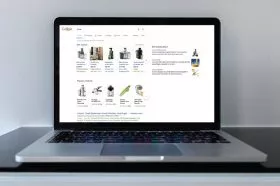Resources - Blog
8 Reasons to Sell on More Marketplaces Than Amazon

Stay on top of the latest e-commerce and marketplace trends.
It has never been easier to sell on Amazon, and the low barriers to entry have inspired entrepreneurs around the world to start an e-commerce business. Selling via Fulfillment by Amazon (FBA) is especially convenient because it will handle inventory storage, fulfillment, and everything in between, leaving online retailers more time and energy to focus on business operations.
However, despite the convenience Amazon offers, it is becoming increasingly necessary for online retailers to expand to multiple marketplaces to ensure stability and ultimately boost sales. Amazon is a common starting point, but there are always risks associated with putting all your eggs in one basket — or all your products on one marketplace.
Risks of Amazon
Amazon recently surpassed Google as the top destination for product searches with more than half (54%) of total searches beginning on its site. The great exposure to consumers is what attracts prospective online retailers to the platform, which promises quick sales in a short period of time. Most high-volume sellers will have some presence on the e-commerce leader’s platform. However, Amazon exerts significant control over its properties, leading to setbacks and limitations for some sellers.
- Seller Suspension
This is, understandably, the biggest fear of Amazon merchants and the top reason to invest in a multi-channel selling strategy. There is a long list of vague reasons why Amazon can pull the plug on your Seller account, and the process of reinstating it is often futile. Suspended sellers who utilize Amazon’s FBA fulfillment service are left with two bad choices: continuing to pay storage fees while unable to sell or paying a per-item fee to have inventory shipped back from an FBA warehouse to try to sell elsewhere.
Depending on the time of year your account is suspended, your business can be hit extra hard. A suspension over Amazon Prime Day, for example, could cost even a small business tens of thousands of dollars in lost revenue. The holidays are a similarly devastating time to face suspension.
Amazon is the best place to reach your customers where they are already shopping, but a multi-channel selling strategy offers a backup plan in the event of suspension or even termination of your seller account.
- Amazon-Controlled Pricing and Listings
Amazon also has the power to control pricing of products as well as where they are listed. Up until this spring, Amazon’s fine print stated that a product’s price could not be higher on Amazon than it was on another platform. The change was made quietly, and though it opens more pricing flexibility for Amazon sellers, it could be reversed at any time as Amazon has the final say on pricing policy for its sellers. Also, if you lower your price for a flash sale or promo event, you may not be allowed to raise it back to its original level.
Last year, many retailers were forced to switch from operating as third-party sellers with full control over their listings to vendors who access the Amazon platform through Vendor Central, essentially becoming a wholesale merchant. The change in policy resulted in narrowed margins and decreased sales across industries, and there are no policies in place to protect current third-party sellers from the same fate.
Fierce Competition
The ease of starting an Amazon business is the reason the market has become so saturated, so sellers are facing more competition than ever. For consumers, this means a wider array of choices and the chance to find better prices. For sellers, the increase in traffic brings in more customers. Competition is not always a bad thing, but selling on Amazon invites competition from your fellow sellers as well as from the e-commerce giant itself.
- From Amazon
Amazon has far more resources than even its highest-volume sellers, including the ability to enter your market and sell duplicate products at a lower price. Prosperous sellers are often a source of inspiration, so Amazon searches larger markets for products that could feasibly make a difference in its revenue as it looks to expand its own private label business.
- From Other Sellers
New sellers enter the Amazon marketplace all the time — more than one million have joined so far this year, according to Marketplace Pulse. That means there are millions of sellers who can copy your listings and use your photos, descriptions, and even product numbers to sell the same items. Amazon asks for documentation of every single product as proof of ownership of intellectual property, which is a time-consuming process that not every seller can afford.
Even worse, other sellers can offer counterfeit versions of your products at lower prices to woo customers. Their eventual dissatisfaction can lead to negative reviews on your seller page, further impacting your sales.
Amazon is a massive company, so resolving these kinds of issues is a lengthy ordeal, even when it is concluded successfully. That is why online sellers need another sales channels to diversify business.
Benefits of Diversifying
Retail is moving toward omnichannel — the fusion of online and offline storytelling that builds brand trust across multiple touchpoints to nurture sales. The online retail platform Magento found that a staggering 98% of consumers want this holistic experience with brands they purchase from, so that alone is reason to think beyond Amazon. These are the other benefits of diversification.
- Expand Your Total Addressable Market
The more places you sell, the more places your customers can reach you (and vice versa). Different demographics are drawn to distinct marketplaces, so multi-channel e-commerce can help you tap into new customer bases you haven’t been able to resonate with before.
- Develop Your Branding
Orders from Amazon come in Amazon-branded boxes delivered by an Amazon driver. This omits the opportunity to create a unique experience with branded packaging, which can close the loop on the buyer journey with a fully branded experience.
However, if you sell products on other marketplaces or on your own website, you take control of the branding: packaging, color palette and fonts, and perhaps thank-you notes or personalized promo codes for your customers. Multi-channel selling gives you the chance to go the extra mile and make the post-purchase experience a memorable one worth repeating.
- Join a Niche Community
If your product fits into a popular category, there is a chance there is a whole marketplace dedicated to that category alone. NewEgg and Rakuten are popular examples of electronics-focused e-commerce sites, whereas Etsy is known for handmade goods. Joining one of these niche communities increases your chances of finding a customer who is looking for products like yours.
- The Risk Is Minimal
The worst result of expanding beyond Amazon is that your products do not sell well on some of the channels you expand to, so all you risk is the monthly seller fee. It is a small price to pay for the potential profits.
Find the Right Tools to Help
Are you ready to take your e-commerce business to the next level? Sellers have a wide variety of tools available to them to help them thrive in the online retail space. From multi-channel management to automated business operations, there are solutions for businesses of all sizes. Once you establish your strategy and determine which tools work best for your needs, you can move faster, make smarter decisions, and stay ahead of the competition.
Learn what Feedvisor can do for your business.
When you partner with Feedvisor, you automatically receive access to our true, AI-driven technology and hands-on team of e-commerce experts. Contact one of our team members today to learn more about our end-to-end solution for brands and large sellers on Amazon, Walmart, and e-marketplaces.




